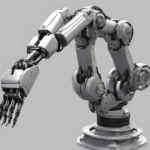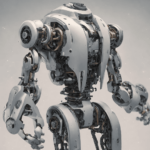What is backlash?
Backlash in mechanical engineering has many names such as lash or play that occurs in mechanical components. It boils down to clearance or lost motion that occurs caused by gaps between parts in the system. It can be thought of as the distance that exists between mated gear teeth. It becomes more noticeable when the direction of movement is changed, and the lost motion is taken before the change in motion is completed. Now, when this is accounted for bearings it becomes increasingly more important depending on the bearing’s implementation. The point of a bearing is to minimize friction, noise, and vibration during operation, all of which create a more efficient product.
Does backlash affect efficiency?
Efficiency can be seen through a variety of methods, but the best way for humanoids is through battery life. The goal for many manufacturers is to design a humanoid that is able to take care of a dull, dangerous, or mundane job such as package unloading from trucks, which would mean that the robot should be able to complete an eight-hour working period to be comparable to human labor. If backlash occurs during this time then it can lead to lower efficiency, which only grows as time moves forward.
How can we minimize backlash in robotic movement?
In a perfect world it would be optimal to have a bearing with zero backlash which would mean that the clearance would be zero as well, but that is essentially impossible due to manufacturing precision, thermal expansion, lubrication, wear, and tear so trying to get to a number as close to zero as possible is the optimal approach when it comes to design parameters. This can be advanced with either a steel/steel bearing which requires grease or a steel/PTFE bearing which is maintenance free and the preferred choice of robotics engineers.
Backlash and Precision
It comes to no surprise that backlash most certainly affects the precision of mechanical systems and components. This can be seen through delays or gaps in motion transfer, uncertainty and inaccuracy, lost motion, and impaired system performance. Which all leads to a humanoid that is unreliable, inefficient, and potentially dangerous to be used around humans.
Delays or Gaps in Motion Transfer
Uncertainty and Inaccuracy
Anything that has to do with a high precision position is going to be greatly affected by backlash as it reduces said precision. When using open-loop or motor positioning the presence of backlash is what presents inaccuracy and uncertainty when changing direction, something humanoids will be constantly doing.
Lost Motion and Vibrations
It is common to think of backlash as being only for gears, but it is a system wide issue that has contributions from many areas of articulation and the actuators in the robot. Not to mention that excessive backlash leads to vibrations which affect the stability and balance of humanoids. This only adds to the complexity of bipedal motion, which is already a challenge many manufacturers are trying to further improve.
Wear and Tear
Backlash is also a contender of increasing wear on components which reduce the overall lifecycle of components and can cause catastrophic failure to occur prematurely and can thus lead to unpredictable humanoids which ultimately once again lead to unsafe humanoid implementation.
How does backlash affect humanoid movement?
Backlash is inversely proportional to precision in mechanical systems and components. As backlash increases, the precision decreases, eventually to a point where the system will not work correctly or at least to a metric that would be considered a complete failure or unusable. So, it is clear that minimizing backlash is a necessity to improve precision and precision is what allows for fluid movement, interaction, and implementation. Making something precise also makes it predictable, something that needs to be accounted for, as it is what will allow for safe usage of humanoids around humans.
Robotic Movement and Humans
It would be a disaster if movement was unpredictable. People would not know what to expect from humanoids, leading to physical injuries, distraction from hazards, and mental stress, all of which will lead to a more inefficient work environment, something that humanoid robots are meant to improve.
Positioning accuracy is a crucial metric for humanoids if they are to be used to help with automation in warehouses. At its most basic point, position accuracy is what will allow the humanoid to pick up a tote and place it in the correct position such as on a conveyor belt or off a shelf. The reason positioning accuracy can be affected by backlash is because of the vibrations it causes during the work period.
How can we manage backlash?
It is currently impossible to create a bearing that has zero backlash as the metrics that are used when developing a bearing in humanoid robots revolve around torque and clearance. As said before, it would be ideal to have a bearing that has zero torque and zero clearance, but just as backlash is to precision, that inversely proportional relationship is also shared by torque and clearance. The more clearance a bearing has the less torque is required to operate. It is about finding the sweet spot between torque and clearance and using that metric to design that bearing. This way managing backlash becomes more controllable.
Testing and Research
With the current state of humanoids, as they are considerably newer than the other products that use bearings and linkage components, many manufacturers have chosen to use off the shelf components for testing that do not align with the complexity and precision that these robots need to have, it would be like using a standard car part for a high-performance sports car. It would get the job done but would not provide precision, control, and feedback that would be desired.
This becomes especially important for testing as feedback and results are what allows for progress in developing a functional humanoid. This is slowed when using parts that were not designed for specific applications. Each humanoid is unique in design and metrics in terms of payload capacity, height, weight, walking speed, and overall physical look, which means that the component specification will vary, and depending on what is used during testing will give its correlated result.
The Most Valuable Asset
The most valuable asset that humanoid developers currently have is time. It cannot be bought or sold, as it can only be used. Making the most out of the time available is what will be reflected on the progress of research, development, and results.
Works Cited
Pencic, M., Cavic, M., & Borovac, B. (2017, November 1). Microsoft word – 20_mpencic et al doi.doc – mas.bg.ac.rs. Development of the low backlash planetary gearbox for humanoid robots. https://www.mas.bg.ac.rs/_media/istrazivanje/fme/vol45/1/20_mpencic_et_al_doi.pdf
Zhang, L., Liao, H., Fan, D., Fan, S., & Zheng, J. (2021, March 17). Design optimization analysis of an anti-backlash geared servo system using a mechanical resonance simulation and experiment. Mechanical Sciences. https://ms.copernicus.org/articles/12/305/2021/
García, P. L., Crispel, S., Saerens, E., Verstraten, T., & Lefeber, D. (2020, June 30). Compact gearboxes for Modern Robotics: A Review. Frontiers. https://www.frontiersin.org/articles/10.3389/frobt.2020.00103/full
About the Author
Nick Jerinic is a robotic engineer with CCTY.


